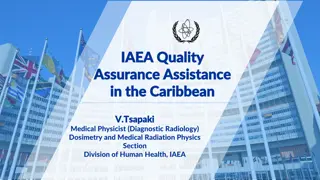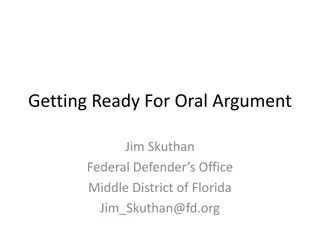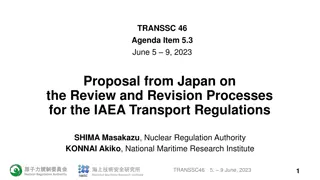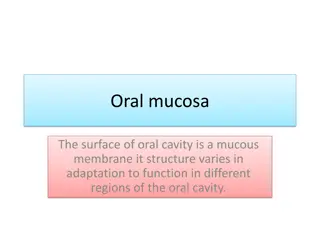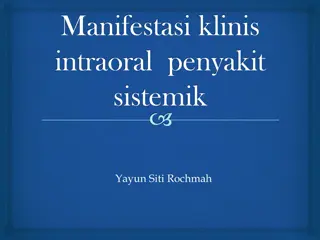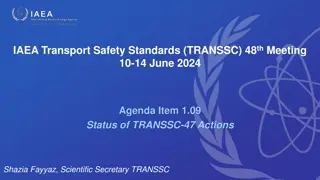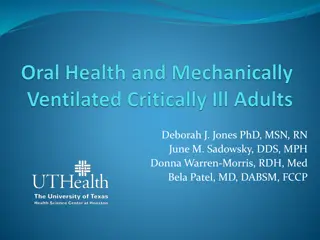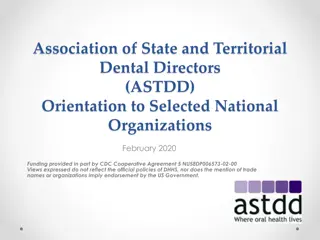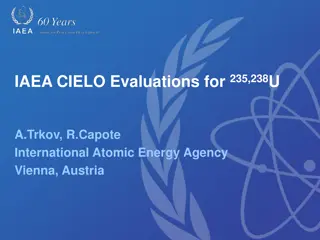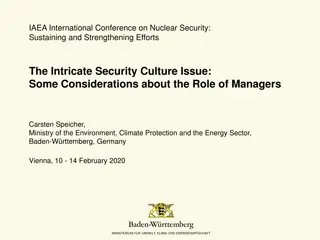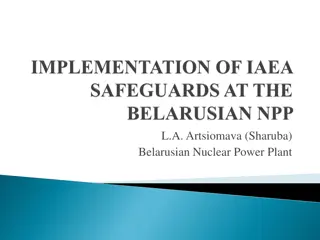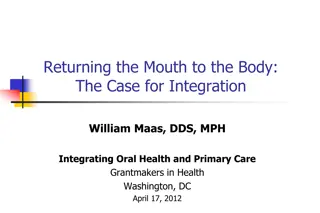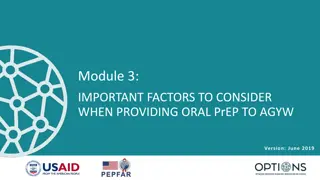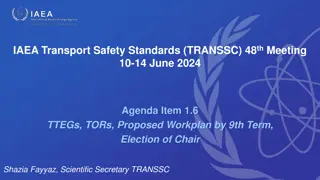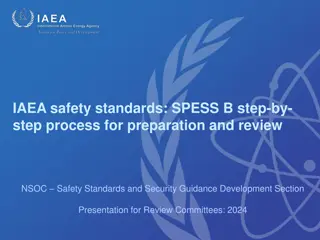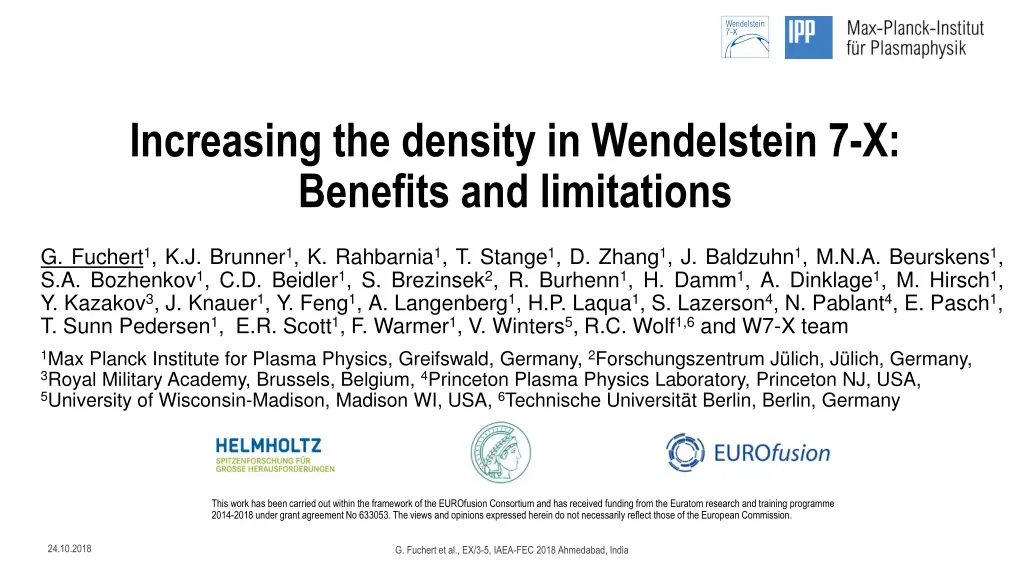
Understanding Density Scaling in Wendelstein 7-X Experiment
Explore the benefits and limitations of increasing density in the Wendelstein 7-X fusion experiment. Discover the empirical scaling, density limitations, and energy confinement before and after boronization. Gain insights into critical density comparisons and analytical modeling.
Download Presentation

Please find below an Image/Link to download the presentation.
The content on the website is provided AS IS for your information and personal use only. It may not be sold, licensed, or shared on other websites without obtaining consent from the author. If you encounter any issues during the download, it is possible that the publisher has removed the file from their server.
You are allowed to download the files provided on this website for personal or commercial use, subject to the condition that they are used lawfully. All files are the property of their respective owners.
The content on the website is provided AS IS for your information and personal use only. It may not be sold, licensed, or shared on other websites without obtaining consent from the author.
E N D
Presentation Transcript
Increasing the density in Wendelstein 7-X: Benefits and limitations G. Fuchert1, K.J. Brunner1, K. Rahbarnia1, T. Stange1, D. Zhang1, J. Baldzuhn1, M.N.A. Beurskens1, S.A. Bozhenkov1, C.D. Beidler1, S. Brezinsek2, R. Burhenn1, H. Damm1, A. Dinklage1, M. Hirsch1, Y. Kazakov3, J. Knauer1, Y. Feng1, A. Langenberg1, H.P. Laqua1, S. Lazerson4, N. Pablant4, E. Pasch1, T. Sunn Pedersen1, E.R. Scott1, F. Warmer1, V. Winters5, R.C. Wolf1,6and W7-X team 1Max Planck Institute for Plasma Physics, Greifswald, Germany, 2Forschungszentrum J lich, J lich, Germany, 3Royal Military Academy, Brussels, Belgium, 4Princeton Plasma Physics Laboratory, Princeton NJ, USA, 5University of Wisconsin-Madison, Madison WI, USA, 6Technische Universit t Berlin, Berlin, Germany This work has been carried out within the framework of the EUROfusion Consortium and has received funding from the Euratom research and training programme 2014-2018 under grant agreement No 633053. The views and opinions expressed herein do not necessarily reflect those of the European Commission. 24.10.2018 G. Fuchert et al., EX/3-5, IAEA-FEC 2018 Ahmedabad, India
Motivation: Density scaling of the energy confinement [Dinklage, NF 47, (2007)] Empirical scaling ISS04 Positive density scaling and negative power scaling ( power degradation ). Triple product benefits from increasing the density. Power and density scaling agree with neoclassical plateau regime. [Dinklage , NF 47, (2007)] ISS04 close to a gyro-Bohm scaling: turbulent transport? 24.10.2018 G. Fuchert et al., EX/3-5, IAEA-FEC 2018 Ahmedabad, India 2
Motivation: Density scaling of the energy confinement Neoclassical prediction for W7-X Neoclassical transport modeling suggests a negative power scaling close to ISS04 and a stronger positive density scaling. [Turkin, PoP 18, (2011)] Increase the density! Limitations? Empirical E scaling? [Turkin 2007 (EPS)] 24.10.2018 G. Fuchert et al., EX/3-5, IAEA-FEC 2018 Ahmedabad, India 3
Outline Energy confinement time before boronization Scaling close to ISS04 Density limited by radiative collapses Critical density Comparison of analytical models with experimental observations Critical density before and after boronizatoin Energy confinement time after boronization Scaling after boronization Energy confinement time at higher densities Summary and conclusion 24.10.2018 G. Fuchert et al., EX/3-5, IAEA-FEC 2018 Ahmedabad, India 4
Energy confinement before boronization Before boronization, E showed a scaling close to ISS04 in hydrogen. Spread of experimental data, not error Densities above ~ 4 1019 /m3 were only accessible transiently with pellet fuelling due to radiative collapses. E~ a0n P Scenario a0 Standard divertor 0.16 0.56 -0.78 Limiter (OP1.1) 0.13 0.75 -0.64 ISS04 - 0.54 -0.61 24.10.2018 G. Fuchert et al., EX/3-5, IAEA-FEC 2018 Ahmedabad, India 5
Density scaling of the energy confinement 24.10.2018 G. Fuchert et al., EX/3-5, IAEA-FEC 2018 Ahmedabad, India 6
Density scaling of the energy confinement 24.10.2018 G. Fuchert et al., EX/3-5, IAEA-FEC 2018 Ahmedabad, India 7
Density scaling of the energy confinement Common phenomenon in stellarators, e.g. in LHD: [J. Miyazawa et al., Fusion Sci. Technol. 58 (2010)] TJ-II: [M.A. Ochando, 41stEPS Conference on Plasma Physics (2014)] W7-AS: [L. Giannone et al., Plasma Phys. Control. Fusion 45 (2003)] W7-A: [G. Cannici et al., Proc. 7th Int. Conf. on Plasma Phys. And Control. Nucl. Fusion (1978)] 24.10.2018 G. Fuchert et al., EX/3-5, IAEA-FEC 2018 Ahmedabad, India 8
Predicting the critical density for strong edge radiation Critical density from the detachment model by Itoh [K. Itoh and S. Itoh, J. Phs. Soc. Jpn. 57 (1988)] Sudo density limit [S. Sudo et al., Nucl. Fusion 30 (1990)] Limits with different transport and radiation models [H. Wobig, Plasma Phys. Control. Fusion 42 (2000)] Modified Itoh model for W7-AS [L. Giannone et al., Plasma Phys. Control. Fusion 45 (2003)] Implicit dependences on transport and edge impurities (low Z) have to be made explicit [Zanca et al., Nucl. Fusion 57 (2017)] 24.10.2018 G. Fuchert et al., EX/3-5, IAEA-FEC 2018 Ahmedabad, India 9
Predicting the critical density for strong edge radiation Critical density from the detachment model by Itoh [K. Itoh and S. Itoh, J. Phs. Soc. Jpn. 57 (1988)] Sudo density limit [S. Sudo et al., Nucl. Fusion 30 (1990)] Limits with different transport and radiation models [H. Wobig, Plasma Phys. Control. Fusion 42 (2000)] Modified Itoh model for W7-AS [L. Giannone et al., Plasma Phys. Control. Fusion 45 (2003)] Implicit dependences on transport and edge impurities (low Z) have to be made explicit [Zanca et al., Nucl. Fusion 57 (2017)] Image courtesy by T. P tterich 24.10.2018 G. Fuchert et al., EX/3-5, IAEA-FEC 2018 Ahmedabad, India 10
Predicting the critical density for strong edge radiation Critical density from the detachment model by Itoh [K. Itoh and S. Itoh, J. Phs. Soc. Jpn. 57 (1988)] Sudo density limit [S. Sudo et al., Nucl. Fusion 30 (1990)] Limits with different transport and radiation models [H. Wobig, Plasma Phys. Control. Fusion 42 (2000)] Modified Itoh model for W7-AS [L. Giannone et al., Plasma Phys. Control. Fusion 45 (2003)] Implicit dependences on transport and edge impurities (low Z) have to be made explicit [Zanca et al., Nucl. Fusion 57 (2017)] W7-X c Configuration Standard 0.56 Details on the magnetic configurations: [J. Geiger et al., Plasma Phys. Control. Fusion 57 (2015)] High-iota 0.59 High-mirror 0.57 24.10.2018 G. Fuchert et al., EX/3-5, IAEA-FEC 2018 Ahmedabad, India 11
Critical density before boronization Hydrogen plasmas with central X2-heating Large scatter in nc Weaker power scaling than predicted (if any ) Possible reasons: Changing impurity content (depending on heating power?) Profile effects, importance of edge density ( ) Model not applicable (local effects, changing main radiator, ) 24.10.2018 G. Fuchert et al., EX/3-5, IAEA-FEC 2018 Ahmedabad, India 12
Critical density before boronization Large scatter in nc Weaker power scaling than predicted (if any ) Possible reasons: Changing impurity content under investigation Profile effects, importance of edge density ( ) Model not applicable local effects exist (e.g. Marfe [U. Wenzel, NF 58 (2018)]), but their importance is unclear Common mitigation strategies: Pellet fueling (decouple core and edge density) [G. Kocsis, T. Szepesi] Wall conditioning by e.g. boronization [->R. Brakel, EX/P8-17] 24.10.2018 G. Fuchert et al., EX/3-5, IAEA-FEC 2018 Ahmedabad, India 13
Critical density after boronization After boronization, radiation from oxygen and carbon lines went down significantly Reduced by a factor of 5 to 10 Only moderate additional boron lines [-> Pedersen et al., EX/9-1] At the same time, ncincreased by a factor of ~3 In the scaling law this would correspond to a reduction of fimpby a factor of 5 to 10 Configurational effects are either absent or subtle fimp=0.5% fimp=1% fimp=5% 24.10.2018 G. Fuchert et al., EX/3-5, IAEA-FEC 2018 Ahmedabad, India 14
Profile effects Estimate edge density by =n0/n0.85 Significantly improved agreement with scaling for ne/ Profile effects are a major source for the scatter in nc 24.10.2018 G. Fuchert et al., EX/3-5, IAEA-FEC 2018 Ahmedabad, India 15
Profile effects Estimate edge density by =n0/n0.85 Significantly improved agreement with scaling for ne/ E? Profile effects are a major source for the scatter in nc 24.10.2018 G. Fuchert et al., EX/3-5, IAEA-FEC 2018 Ahmedabad, India 16
Energy confinement at higher densities Scenario a0 Energy confinement after boronization After boronization 0.16 0.38 -0.59 ISS04 - 0.54 -0.61 For simplicity, only X2-heated plasmas are shown In O2 similar observations, but Pabsorbed< Pheat. Also in these experiments a positive density scaling of Eis found. This trend can be observed even in single experiments. Density scaling gets weaker at high frad=Prad/PECRHor densities close to nc. 24.10.2018 G. Fuchert et al., EX/3-5, IAEA-FEC 2018 Ahmedabad, India 17
Energy confinement at higher densities Scenario a0 Energy confinement after boronization After boronization 0.16 0.38 -0.59 ISS04 - 0.54 -0.61 For simplicity, only X2-heated plasmas are shown In O2 similar observations, but Pabsorbed< Pheat. Also in these experiments a positive density scaling of Eis found. This trend can be observed even in single experiments. Density scaling gets weaker at high frad=Prad/PECRHor densities close to nc. Only accessible after boronization 24.10.2018 G. Fuchert et al., EX/3-5, IAEA-FEC 2018 Ahmedabad, India 18
Energy confinement at higher densities Scenario a0 Energy confinement after boronization After boronization 0.16 0.38 -0.59 ne> 4 1019/m3 ISS04 0.11 0.62 -0.64 For simplicity, only X2-heated plasmas are shown In O2 similar observations, but Pabsorbed< Pheat. Also in these experiments a positive density scaling of Eis found. This trend can be observed even in single experiments. Density scaling gets weaker at high frad=Prad/PECRHor densities close to nc. - 0.54 -0.61 24.10.2018 G. Fuchert et al., EX/3-5, IAEA-FEC 2018 Ahmedabad, India 19
Energy confinement at higher densities Scenario a0 Energy confinement after boronization After boronization 0.16 0.38 -0.59 ne> 4 1019/m3 ISS04 0.11 0.62 -0.64 For simplicity, only X2-heated plasmas are shown In O2 similar observations, but Pabsorbed< Pheat. Also in these experiments a positive density scaling of Eis found. This trend can be observed even in single experiments. Density scaling gets weaker at high frad=Prad/PECRHor densities close to nc. - 0.54 -0.61 ? 24.10.2018 G. Fuchert et al., EX/3-5, IAEA-FEC 2018 Ahmedabad, India 20
Energy confinement close to nc Before boronization, the density scaling becomes weaker above ~0.5 nc,5% After boronization, the density scaling becomes weaker above ~1.0 nc,5% fradincreases with ne/nc As it was shown before, high densities as such are not an issue 24.10.2018 G. Fuchert et al., EX/3-5, IAEA-FEC 2018 Ahmedabad, India 21
Summary and conclusion Energy confinement time in W7-X Improves with density, roughly in-line with ISS04 ( E~n0.54). Improvement obviously limited by radiative collapses. Critical density can be estimated from analytical models. Boronization crucial to achieve relevant densities. 24.10.2018 G. Fuchert et al., EX/3-5, IAEA-FEC 2018 Ahmedabad, India 22
Summary and conclusion Energy confinement time in W7-X Not one single scaling law for the entire parameter range. Unravelling the main transport/loss channels has only started. Plasmas with pellet-fueling [-> Bozhenkov et al., EX/P8-8] or O2 and NBI-heating are not even included in the analysis yet. E scalingsneed to take different regimes and operational limits into account. This is well established for tokamaks, but not yet for stellarators. 24.10.2018 G. Fuchert et al., EX/3-5, IAEA-FEC 2018 Ahmedabad, India 23

